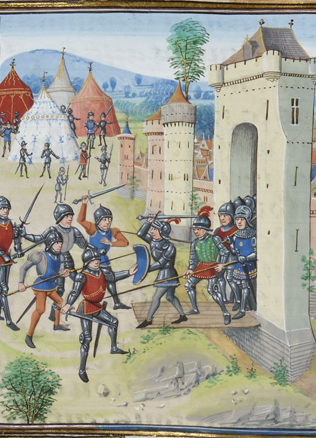Symbols in the 14th-century Jewellery
Different times, different ornaments
In the European context, prehistoric adornments, with their distinctive forms and elements of décor, represent one of the key elements that illustrate the original Baltic culture. It was not before the Middle Ages, when the Lithuanian state emerged and Christian values were spreading around the country erasing cultural differences between the tribes, that the types and décor in the lands inhabited by Balts began becoming similar to those in broader Europe.
Symbols used by the 14th century adornment makers were somewhat different than these cherished by their ancestors hundreds of years prior to that, because European traditions and city culture started seeping into the country.
Jewellers, who earlier were concerned only about satisfying the traditional requirements of local communities, now were working for the markets expecting much more of cultural innovation. New motives reflecting the broader cultural context began emerging in the jewellery of the Balts. Some of them are to be attributed to Christian symbols. Nobody knows, however, what was going through the mind of an artisan of the time who has never seen a priest speaking Lithuanian.
In his monograph The Christianisation of the Grand Duchy of Lithuania Between the Late 14th Century and the 15th Century, archaeologist Eugenijus Svetikas maintains that three embossed “gems” could mean the Holy Trinity, while the five dots possibly stood for the five sacred wounds of Jesus Christ. He also suggests that the “number of the beast from the Apocalypse, 666, can be clearly seen on the hexagonal […] brooch”. Other specialists, however, have put forward different opinions as to what these symbols could mean for the societies of the time.
Decorated and marked
Headbands, or chaplet-shaped female adornments, found in the 13th and 14th century necropolis in Kernavė offer an astounding variety of symbols and ornaments. There is no other category of adornments possessing such a vast spectre of symbolic motives. Plate-brooches usually bear winding herb-motive ornamentation or combinations of dots and tiny “suns”. Rhomb-shaped lavaliers are decorated with a huge variety of embossed “gems” often forming a cross. Rings with wider front segment have only three variants of decoration: two triangles, variations of oblique crosses, and tiny “suns”. The symbols used on headbands are considerably more varied. Women wore headbands on their foreheads, the open and “declarative” zone.
Over different epochs, women’s headgear was meant to reflect her family status, social rank and wealth.
Doesn’t it explain the saying that has survived until our times, “everything’s written on her forehead”?
The language of the adopted symbols
Plant and herb motives dominate headbands unearthed in Kernavė, a palmette being the most common symbol. A palmette, or a fruitful tree of life, was a symbol of fertility in the Byzantine monumental art and is often seen on various jewellery items, such as temporal adornments (also known as kolts), bangles and diadems, made between 11th and 13th century in Slavic lands. Using imagination, one will see an anthropomorphic (perhaps female) figure, a stylised symbol of heraldic lily, or something else.
Scientists still argue about the interpretation of many symbols from these times.
One headband from Kernavė is decorated with a symbol of heraldic lily. The sign of lily, sometimes referred to as “the French lily”, was widespread in European heraldry. Necklaces made of silver heraldic lily-shaped links were produced in Navahrudak, the city that belonged to the GDL at the time. Several such necklaces have been found in Kernavė too. In addition to that, heraldic lilies are impressed into several pieces of birch bark found in the 13th– and 14th-century homestead in the Valley of Pajauta where a family of bone-carver once lived.
One headband offers the entire story rather than just a symbol. The centre of the headband is dominated by a vertical figure, resembling a tree with upward branches, and two S-shaped symbols – one on each side of the figure. The compositional solution of the image is reminiscent of a stylised symbol of “ascension”. In its centre, one can see a human figure holding hands up pulled by two mystical winged creatures. The similar image of Alexander the Great “ascending to heavens”, familiar to ancient people in Europe and the Middle East, gained different meaning on adornments made in Slavic lands. According to Russian archaeologists, this was the symbol of the pagan giving deity (deus dator), the god of sun Dažbog. It is not clear what would the female owner of the headband in the Kernavė of the 14th century think of these symbols.
Between paganism and Christianity
A couple of headbands feature a motive of oblique cross, each of its transverse bars crossed by minute dashes. One of the headbands bears a symbol of swastika. It is very unlikely that the cross-decorated headbands are to be linked to the Christian symbolism. The cross, and particularly its revolving version, a swastika, was a solar symbol for pagans. Among other findings in Kernavė, archaeologists have unearthed rings with swastikas and swastika-shaped metal decorations. People in Kernavė also had swastikas impressed into some of their household items, such as peels and pots.
A lion was a new symbol the Balts began using to decorate metal items. Two headbands found in Kernavė feature embossed lion-like beasts, their front paws under their body, their tails up. The local jewellers might have been aware of the symbolic meaning of a lion. The same symbol also appears on purse decorations found in old graves throughout Lithuania. The reverse of one of the first coins minted by Jagiełło features a lion too.
The aforementioned symbols found on the 14th-century jewellery of the GDL point to profound cultural changes within the society influenced by Christian, European and urban civilisation.
Gintautas Vėlius



